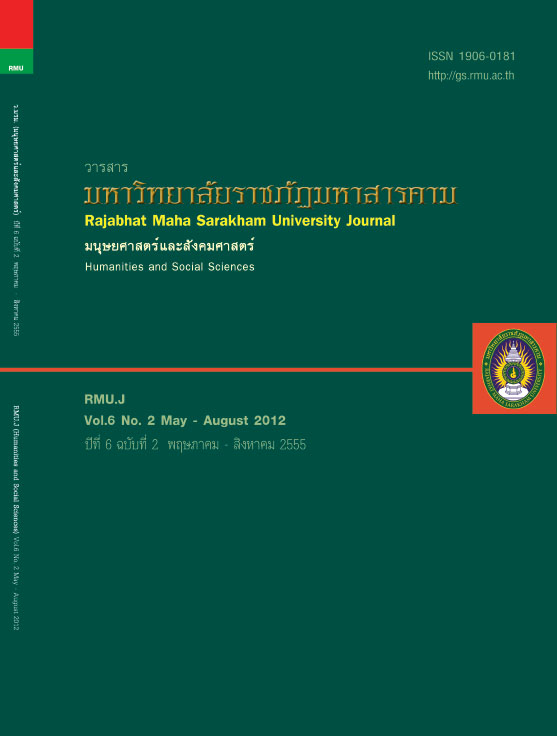การเปรียบเทียบผลการเรียนด้วยเทคนิคการคิดทางวิทยาศาสตร์ที่ดี โดยใช้เทคนิคการรู้คิดที่มีต่อการเปลี่ยนแปลงแนวความคิดเลือกเกี่ยวกับมโนมติชีววิทยา : เซลล์การแบ่งเซลล์ และการเคลื่อนที่ของสารผ่านเซลล์ และการคิดวิพากษ์วิจารณ์ของนักเรียนชั้นมัธยมศึกษาปีที่ 4
Main Article Content
บทคัดย่อ
การวิจัยครั้งนี้มีวัตถุประสงค์เพื่อศึกษาและเปรียบเทียบผลการเรียนด้วยเทคนิคการคิดทางวิทยาศาสตร์ที่ดี โดยใช้เทคนิคการ
รู้คิด ที่มีต่อการเปลี่ยนแปลงแนวความคิดเลือกเกี่ยวกับมโนมติชีววิทยา : เซลล์ การแบ่งเซลล์ และการเคลื่อนที่ของสารผ่านเซลล์
และการคิดวิพากษ์วิจารณ์ ของนักเรียนชั้นมัธยมศึกษาปีที่ 4 ที่มีผลการเรียนชีววิทยาต่างกัน จำนวน 42 คน ได้มาจากการสุ่มแบบ
กลุ่ม (Cluster random sampling technique) เครื่องมือที่ใช้ในการเก็บรวบรวมข้อมูลประกอบด้วย แผนการจัดการเรียนรู้ด้วย
เทคนิคการคิดทางวิทยาศาสตร์ที่ดี โดยใช้เทคนิคการรู้คิด 3 ประเภท ได้แก่ ความสามารถเข้าใจได้ (Intelligibility) ความสามารถเชื่อ
ถือได้ (Plausibility) และความสามารถนำไปใช้ได้อย่างกว้างขวาง (Wide-applicability) จำนวน 3 แผน แผนละ 2 ชั่วโมง/สัปดาห์
และแบบทดสอบวัดแนวความคิดเลือกเกี่ยวกับมโนมติชีววิทยา : เซลล์ จำนวน 6 ข้อ การแบ่งเซลล์ จำนวน 2 ข้อ และการเคลื่อนที่
ของสารผ่านเซลล์ จำนวน 9 ข้อ และแบบทดสอบวัดการคิดวิพากษ์วิจารณ์ จำนวน 5 ด้าน ได้แก่ การอนุมาน การยอมรับข้อตกลง
เบื้องต้น การนิรนัย การตีความ และการประเมินข้อโต้แย้ง จำนวน 54 ข้อ สถิติที่ใช้ในการทดสอบสมมติฐาน ได้แก่ t-test, F-test
(One-way ANCOVA) และ Chi-square test ผลการวิจัยพบว่า
1. นักเรียนโดยส่วนรวม นักเรียนที่มีผลการเรียนชีววิทยาสูง และนักเรียนที่มีผลการเรียนชีววิทยาตํ่า หลังเรียนด้วยเทคนิคการ
คิดทางวิทยาศาสตร์ที่ดี โดยใช้เทคนิคการรู้คิดมีความเข้าใจอย่างสมบูรณ์เพิ่มขึ้น แต่มีแนวความคิดที่ผิดพลาดในมโนมติเซลล์ การ
แบ่งเซลล์ และการเคลื่อนที่ของสารผ่านเซลล์ ลดลงจากก่อนเรียน อย่างมีนัยสำคัญทางสถิติที่ระดับ .05
2. นักเรียนโดยส่วนรวม นักเรียนที่มีผลการเรียนชีววิทยาสูง และนักเรียนที่มีผลการเรียนชีววิทยาตํ่า ที่เรียนด้วยเทคนิคการคิด
ทางวิทยาศาสตร์ที่ดี โดยใช้เทคนิคการรู้คิด มีการคิดวิพากษ์วิจารณ์ ทั้งโดยรวมและเป็นรายด้านทุกด้าน เพิ่มขึ้นจากก่อนเรียน อย่าง
มีนัยสำคัญทางสถิติที่ระดับ .05
3. นักเรียนที่มีผลการเรียนชีววิทยาสูง ที่เรียนด้วยเทคนิคการคิดการคิดทางวิทยาศาสตร์ที่ดี โดยใช้เทคนิคการรู้คิด มีการ
คิดวิพากษ์วิจารณ์หลังเรียนโดยรวมและเป็นรายด้าน จำนวน 4 ด้าน คือ ด้านการยอมรับข้อตกลงเบื้องต้น ด้านการนิรนัย ด้านการ
ตีความ และด้านการประเมินข้อโต้แย้งมากกว่านักเรียนที่มีผลการเรียนชีววิทยาตํ่า อย่างมีนัยสำคัญทางสถิติที่ระดับ .05
This research aimed to investigate and compare the effects of learning through good science thinking
moves using metacognitive on 10th grade students of different biology learning achievements in changing
alternative conceptions of some biology concepts: Cell, Cell Division and Transport of Materials through
Cell and critical thinking abilities. Subjects were 42 Mathayomsuksa 4 students with different biology learning
achievements, selected through cluster random sampling. Instruments for the study were 1) 3 two-hour
instructional plans on the three mentioned biology concepts using the good science thinking moves with 3
metacognitive moves : Intelligibility, Plausibility, and Wide-applicability; 2) a test on alternative conceptions
of cell(6 items), cell division( 2 items), and transport of materials through cell(9 items); and 3) a 54-item
test on critical thinking ability with 5 specific aspects: inference, recognition of assumptions, deduction,
interpretation, and evaluation of arguments. The statistics employed for testing research hypotheses were
t-test, F-test (One-way ANOVA) and Chi-square test.
Findings reveal the following:
1. In general, the students of both high and low achievement showed gains in instances of sound
understanding and thinking; and they showed decrease in instances of specific misconception from before
learning at the .05 level of significance.
2. The students, both high achievers and low achievers, showed increase in critical thinking abilities,
overall and every specific aspect, from before learning at the .05 of significance.
3. The high achievers’ posttest achievement in critical thinking abilities, both overall and specific
aspects (recognition of assumptions, deduction, interpretation, and evaluation of arguments) was higher
than that of the low achievers at the .05 level of significance.
Article Details
1. บทความที่ลงตีพิมพ์ทุกเรื่องได้รับการตรวจทางวิชาการโดยผู้ประเมินอิสระ ผู้ทรงคุณวุฒิ (Peer Review) สาขาที่เกี่ยวข้อง อย่างน้อย 3 ท่าน ในรูปแบบ Double blind review
2. ข้อคิดเห็นใด ๆ ของบทความที่ลงตีพิมพ์ในวารสารมหาวิทยาลัยราชภัฏมหาสารคาม นี้เป็นของผู้เขียน คณะผู้จัดทำวารสารไม่จำเป็นต้องเห็นด้วย
3. กองบรรณาธิการวารสารมหาวิทยาลัยราชภัฏมหาสารคาม ไม่สงวนสิทธิ์การคัดลอกแต่ให้อ้างอิงแสดงที่มา


